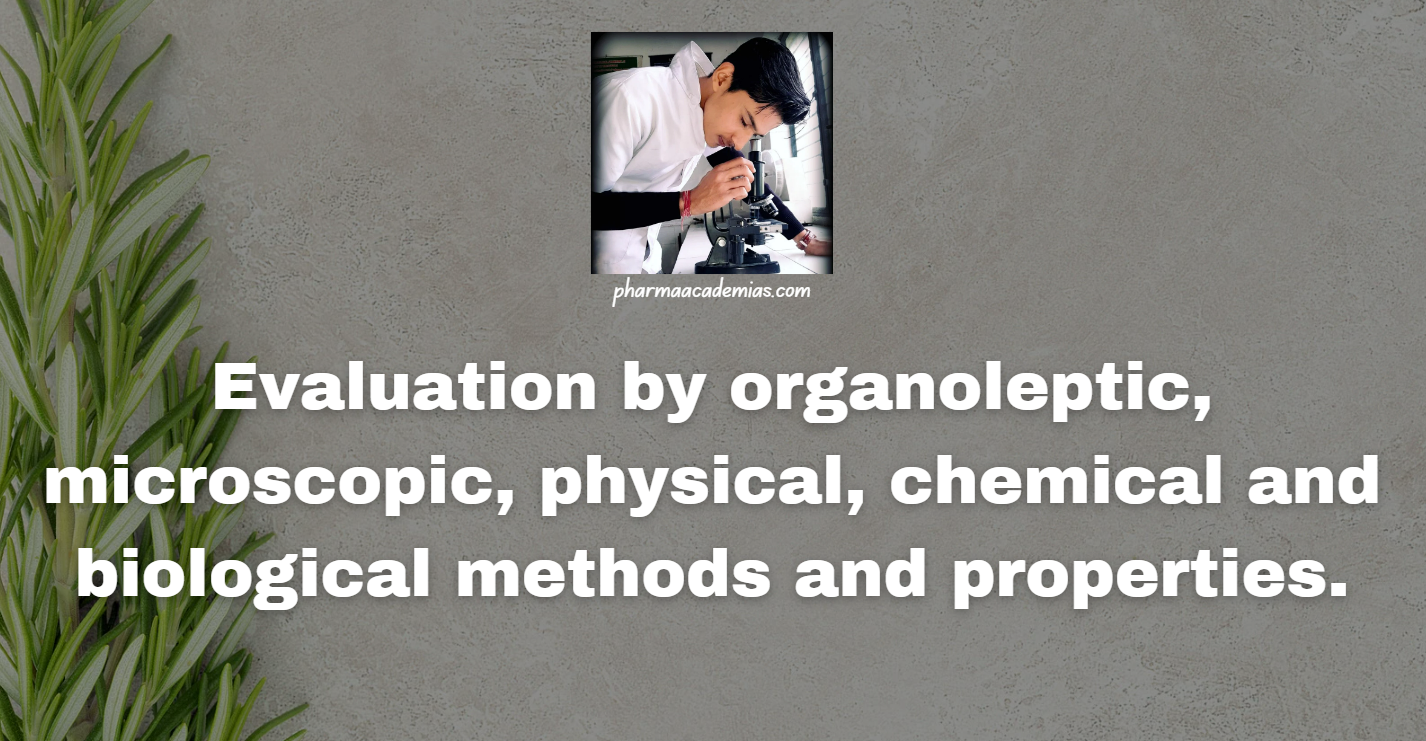Evaluation by organoleptic, microscopic, physical, chemical, and biological methods and properties is a comprehensive approach used in the quality assessment of drugs, particularly those of natural origin. These methods involve the assessment of various characteristics, ranging from sensory properties to biochemical composition, to ensure the identity, purity, and quality of medicinal substances. Let’s delve into a detailed note on each of these evaluation methods:
1. Organoleptic Evaluation
Organoleptic evaluation involves the sensory assessment of drugs based on their physical properties, such as appearance, color, odor, taste, and texture.
Methods: Trained evaluators use their senses (sight, smell, taste, touch) to detect any deviations from the expected characteristics.
Importance: Organoleptic evaluation provides initial indications of drug quality and authenticity, helping identify any visible signs of deterioration, contamination, or adulteration.
Examples: Assessing the color, aroma, and taste of herbs, spices, and herbal teas; examining the texture and appearance of herbal extracts and ointments.
2. Microscopic Evaluatio
Microscopic evaluation involves the examination of drugs under a microscope to observe their cellular and structural characteristics.
Methods: Thin sections or powdered samples of drugs are prepared and examined under a light microscope or electron microscope.
Importance: Microscopic evaluation helps identify the presence of specific plant parts (e.g., trichomes, stomata, vascular bundles), which can aid in botanical identification and authentication.
Examples: Identifying characteristic cell structures and tissue patterns in herbal drugs, verifying the presence of pollen grains or spores for species identification.
3. Physical Evaluation
Physical evaluation assesses the physical properties of drugs, including particle size, density, solubility, and moisture content.
Methods: Various physical tests and measurements are conducted using instruments such as sieves, balances, refractometers, and moisture analyzers.
Importance: Physical evaluation provides quantitative data on drug properties, which are essential for formulation, dosage determination, and quality control.
Examples: Particle size analysis of herbal powders, determination of bulk density and tapped density of herbal extracts, measurement of moisture content in herbal materials.
4. Chemical Evaluation
Chemical evaluation involves the analysis of drugs to determine their chemical composition, including the presence and concentration of specific constituents or active compounds.
Methods: Analytical techniques such as chromatography (e.g., HPLC, GC), spectroscopy (e.g., UV-Vis, IR, NMR), and mass spectrometry are used for chemical analysis.
Importance: Chemical evaluation provides information on the identity, purity, and potency of drugs, facilitating quality control and standardization.
Examples: Quantification of marker compounds or bioactive constituents in herbal extracts, identification of adulterants or contaminants using chemical profiling techniques.
5. Biological Evaluation
Definition: Biological evaluation assesses the biological activity and pharmacological effects of drugs using in vitro or in vivo assays.
Methods: Bioassays, cell culture studies, and animal experiments are conducted to evaluate pharmacological properties such as antimicrobial activity, antioxidant activity, and cytotoxicity.
Importance: Biological evaluation provides insights into the therapeutic potential and safety profile of drugs, guiding their clinical use and dosage recommendations.
Examples: Determining the antimicrobial activity of plant extracts against pathogenic bacteria, assessing the antioxidant capacity of herbal supplements using cell-based assays, evaluating the toxicity of natural products in animal models.
Conclusion
Evaluation by organoleptic, microscopic, physical, chemical, and biological methods and properties is a comprehensive approach used in the quality assessment of drugs, particularly those derived from natural sources. By combining these evaluation methods, researchers, manufacturers, and regulatory authorities can ensure the identity, purity, potency, and safety of medicinal substances, thereby safeguarding public health and promoting the quality of herbal medicines and natural products.

